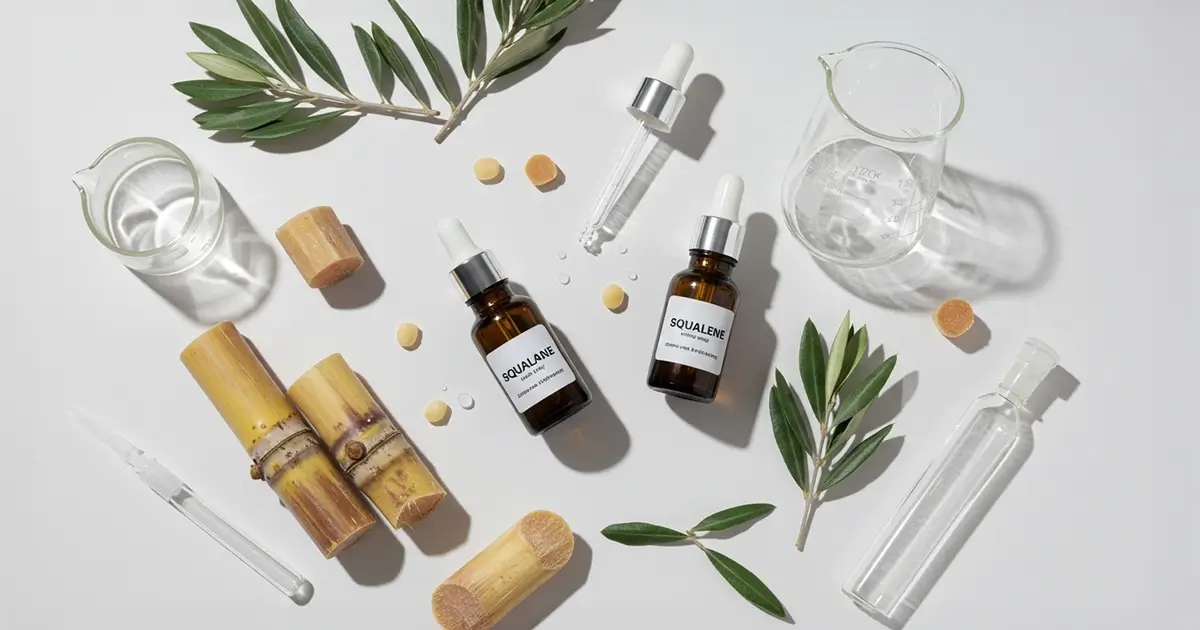I'm putting two almost-twins under the microscope today: squalane and squalene. By the end you'll know how they differ in chemistry, skin feel, shelf life, and planet impact - so you can choose the right plant-derived lipid with zero confusion.
What Are We Even Talking About?
Squalene occurs naturally in human sebum and in certain plants, but its six double bonds make it as reactive as a toddler after double espresso. Chemists calm that energy by hydrogenating it, turning every double bond into a single one, and voilà: squalane, the saturated, skin-friendly version that will not oxidise before you finish the bottle.
This small tweak changes everything. Squalene feels richer, sometimes a touch greasy, and becomes rancid quickly when exposed to air. Squalane, on the other hand, slips on like silk and stays stable for years even if you forget to screw the cap on properly - though please don't test that on purpose.
Both molecules mimic our own lipids, so skin recognises them as old friends rather than strangers. That biocompatibility is why you'll spot at least one of them hiding in moisturisers, serums, or - even trendier - pure-oil dropper bottles.
Feel, Stability, and Efficacy on Skin
Let's start with texture. I find squalane practically weightless; it sinks in within seconds and leaves a velvety finish that works under sunscreen without pilling. Squalene sits heavier, making it a comfort blanket for severely dry spots but a potential pore-clogger if your T-zone likes to throw tantrums.
Stability is where the hydrogenation payoff shines. Squalane shrugs off heat and light with cosmopolitan ease, while squalene oxidises, turns sticky, and can generate irritant by-products no one invited to the party. If you're the type who keeps skincare on a sunny vanity for the aesthetic - hi, guilty - pick squalane.
Efficacy goes beyond moisturising. In a 2024 lab trial, dermal fibroblasts bathed in squalane kept producing healthy collagen even under UVA stress - in this study researchers noted lowered oxidative markers, calmer inflammation signals, and happier cells overall. That's science code for "your future wrinkles might appear fashionably late."
Sourcing and Sustainability Matters
Older generations of the cosmetic world harvested squalene from deep-sea shark livers - a practice that makes my stomach do somersaults. Thankfully biotech caught up: olives, amaranth seeds, rice bran, and sugarcane now headline production, with fermentation tech leading the low-carbon charge.
Fermented sugarcane squalane wins extra green points. Yeast munches on sugar, pumps out farnesene, chemists hydrogenate it, and we get a renewable, traceable supply free from marine guilt. Brands love to flaunt those credentials, and I, for one, happily reward them with enthusiastic cart-clicks.
Cost and footprint still differ. Olive-derived squalene is seasonal and land-intensive, so prices swing wider than my mood before coffee. Fermentation scales in stainless-steel tanks, offering a steadier, shark-free stream - plus a smaller carbon invoice.
How I Pick and Use Them in Daily Life
Reading the Ingredient List
If I spot "squalane" in the top five ingredients, I know the product will feel featherlight. A mid-list "squalene" label signals heavier occlusion - perfect for overnight slugging sessions when my heater steals all humidity. (Yes, slugging jokes are still legal; no actual slugs were consulted.)
Stand-Alone Oils
Pure squalane gets my vote for everyday facial use and for diluting strong actives. Three drops turn retinol into a polite neighbour instead of a loud upstairs drummer. Speaking of actives, if you like nerding out on natural versus lab-made ingredients, peek at my earlier article right here for a deeper dive.
Body and Hair Hacks
- Body: I mix a teaspoon of squalene into body cream during winter, creating a cocoon that laughs at dry radiator air.
- Hair: One pump of squalane tames split ends without turning strands into an oil slick - just remember less is more unless you're auditioning for a 90s boy-band video.
FAQ
Is squalane safe for acne-prone skin?
Yes. Its lightweight, saturated structure makes it non-comedogenic for most people, and studies report negligible irritation rates even on breakout-prone faces.
Can vegans use squalene products?
Check the source. Plant or biotech versions are vegan-friendly, but some older formulas still rely on shark-derived squalene. When in doubt, brand-email time.
Does squalane replace my moisturiser?
Think of it as an emollient booster, not a full routine. Pair it with humectants and occlusives if you want all-day hydration - teamwork makes the dream work, as my tenth-grade lab partner once said.
Will squalene always oxidise on my shelf?
Oxidation risk is high but not inevitable. Dark glass, cool storage, and antioxidant buddies like vitamin E slow the process, though squalane still wins the longevity trophy.
Can I mix squalane with strong actives?
Absolutely. It plays nicely with retinoids, acids, and niacinamide, often reducing irritation without blocking absorption. Just patch-test as usual; your skin is unique, not a laboratory beaker.
Conclusion
Squalane and squalene start from the same family tree yet behave like wildly different cousins: one calm, stable, and featherlight, the other richer, more reactive, and in need of careful storage. Match their quirks to your skin needs and sustainability values, and you'll unlock a versatile lipid toolkit.
Have questions or a funny squalane mishap to share? Pop them in the comments so we can compare notes. See you in the next post - until then, take good care of your skin!


Comments (0)
No comments yet - be the first to share your thoughts!
Leave a Reply
Your email address will not be published. Required fields are marked *